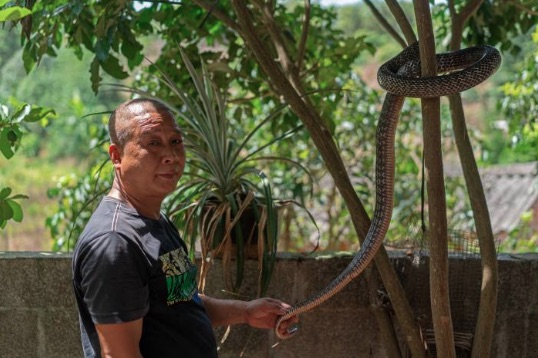In a Financial Times feature, China’s ban on breeding and eating land-based wildlife in response to the Covid pandemic, is explored.
On the outskirts of Bolao town, five minutes down an overgrown dirt track into the jungle of southern China’s Guangxi region, Hua Chaojiang breeds cobras by the hundred. An acrid smell and a chorus of angry hisses meet us when we step into the darkness of the three-storey red-brick building. Hua, who has been raising snakes for 20 years, is unfazed. He reaches into one of the pens, grabs a tail and casually lifts up a complaining — and venomous — elapid snake.
The four-year-old cobra is about as thick as Hua’s muscled arm and nearly twice as long. Hua laughs when asked whether the poisonous snakes have ever bitten him. “Of course,” he replies, using a metal pole with a hook to keep its fangs away from his body.
Despite their impressive size, Hua’s cobras are starving. Some are already dead. It is six months since the Chinese government banned the breeding and consumption of snakes and other land-based wildlife, as part of its response to the discovery of a novel coronavirus in the central city of Wuhan.
Now that Covid-19 has turned from an epidemic to a pandemic, China’s prohibition looks like it could become permanent, leaving Hua with thousands of snakes and nowhere to put them. “If there is no market, what can I do with them?” he asks.
To save money, Hua has cut down feeding from five times to once a week. Even so, his walk-in freezer is nearly empty of frozen cockerels. The hunger makes the cobras restless. “Snakes fight snakes. Snakes eat snakes,” he says.
The snake trade has been lucrative for Hua. Before the ban, a snake would sell for about Rmb50 (more than $7) per kilogramme in markets in neighbouring Guangdong province. He has been growing his business steadily since the 1990s, when he first started keeping cobras in a small shed with half a dozen snake pens.
Later he invested profits in a new building to keep the poisonous reptiles further from neighbours. He attended courses with snake-breeding experts and passed tests to become a qualified breeder.
As he expanded he moved most of his stock into the jungle, although he still keeps a few pits of oriental rat snakes, which are not venomous, on his original farm. In 2016, the industry of breeders and restaurants that used wild animals for meat was estimated to have a total value of Rmb125bn ($18bn).
The government has promised to compensate breeders, but the process keeps being delayed. Hua, 50, has had to borrow money to keep the business from total collapse.
“Since the epidemic came, it’s not been possible to sell anything. I’m losing money on buying the chicks to feed them, on paying workers, on everything.” He and other breeders travelled to the regional capital of Nanning to petition the government — to no avail. Officials talk of finding new employment for breeders but Hua struggles to imagine what that could be. “I only know how to breed snakes,” he says.
The exact pandemic transmission pathway remains unclear; the best genetic matches for Sars-Cov-2, the virus that causes Covid-19, have been of coronaviruses carried by horseshoe bats from the southwestern Yunnan province.
But some scientists believe the virus passed through an intermediate host before reaching humans. The pangolin, a scaly anteater once common in Asia but now endangered by high levels of poaching and trafficking, is one possible host; another early suggestion, later shown to be unlikely, was snakes.
As the country where the pandemic began, China has faced intense pressure to clean up its wildlife trade and urban live animal markets to safeguard against future outbreaks.
Haunted by multiple past outbreaks — notably, severe acute respiratory syndrome, or Sars, in 2003, which was traced back to palm civets — the government has responded sharply, with the emphasis on shutting down the illegal wild animal trade. The prohibition has been hailed by environmentalists and epidemiologists alike, but many have called for it to be expanded and made permanent.























